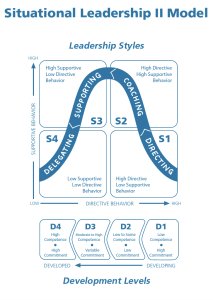Situational Leadership: Understanding Ken Blanchard’s Model
 March 23, 2023
March 23, 2023
 No Comments
No Comments

Effective leadership is essential to the success of any organization. One approach to leadership is situational leadership, a model developed by Ken Blanchard and Paul Hersey. This approach involves adapting one’s leadership style based on the situation and the needs of the individuals being led. In this blog, we will explore the situational leadership model developed by Ken Blanchard.
Understanding Situational Leadership
Situational leadership is a leadership model that suggests leaders should adapt their leadership style based on the needs of their followers. The model suggests that there is no one-size-fits-all approach to leadership, and the leader should adjust their approach based on the individual or team being led. The situational leadership model is based on two key elements: leadership style and the maturity level of the followers.
Leadership Style
The situational leadership model suggests that there are four leadership styles: directing, coaching, supporting, and delegating. Each style is appropriate in different situations, and leaders should be able to adapt their style to fit the situation.
- Directing: The directing style is appropriate when the follower is new to a task and needs clear instructions and guidance.
- Coaching: The coaching style is appropriate when the follower has some experience but needs additional support and guidance to develop their skills.
- Supporting: The supporting style is appropriate when the follower has the necessary skills and experience, but may lack confidence or motivation.
- Delegating: The delegating style is appropriate when the follower is experienced and capable of taking on a task independently.
Maturity Level
The situational leadership model also suggests that followers’ maturity level should be considered when determining the appropriate leadership style. Maturity level is determined by the follower’s competence and commitment. Competence refers to the follower’s skills and ability to complete a task, while commitment refers to their motivation and confidence.
There are four maturity levels:
- M1: The follower is unable and unwilling to complete a task.
- M2: The follower is unable but willing to complete a task.
- M3: The follower is able but unwilling to complete a task.
- M4: The follower is both able and willing to complete a task.
Using the Model
The situational leadership model suggests that leaders should adapt their leadership style based on the follower’s maturity level. For example, if a follower is at maturity level M1, the leader should use the directing style to provide clear instructions and guidance. If a follower is at maturity level M4, the leader should use the delegating style and give the follower the freedom to complete the task independently.
The situational leadership model suggests that leaders should be flexible and willing to adapt their leadership style based on the situation and the needs of the followers. Leaders who use this approach can create a supportive environment that encourages growth and development.
Conclusion
Effective leadership is essential to the success of any organization, and the situational leadership model developed by Ken Blanchard is one approach that can help leaders. If you’d like to learn more about this model or other ways to grow in you and your team’s leadership, please don’t hesitate to reach out.
 Blog Home
Blog Home
Popular Posts
- Is there significance in “656”? 17 views
- Unlock Growth: What You Should Start, Stop, and Continue for Success 14 views
- Find Out What’s Holding Your Business Back—It Might Be You 11 views
- Transform Your Marketing Results with the Conversion Equation—Get More Customers Today 11 views
- Does God speak through yellow birds! 9 views
- If at first you don’t succeed, you’re in good company. 8 views
- Is Lencioni’s The Five Dysfunctions of a Team outdated? 7 views
- From Survival to Significance: Elevating Small Business Through Purpose 6 views
- One Play Can Change the Game – Will You Be Ready to Make Yours? 4 views
- Harness the Power of Emotions to Win More Clients 4 views
Categories
- 5 Part Profit Framework (27)
- Books (41)
- Business (210)
- Case Studies (6)
- Faith (135)
- Family (83)
- Farm 360 (5)
- Finances (21)
- Fitness (7)
- Freedom (23)
- Friends (25)
- Fun (5)
- Hearing God's Voice (59)
- Leadership (99)
- Leadership Development (68)
- Marketplace Ministry (29)
- Mentor (37)
- Personal (188)
- Retreats (10)
- Speaking (8)
- Strategic Planning (62)
- Team Alignment (59)
- Teambuilding (58)
- Teens (24)
- Testimonials (12)
- TPCC (32)
- TruthAtWork (57)
- What Matters (11)

Leave a Reply